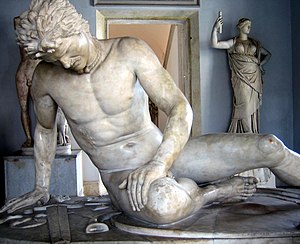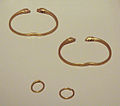Galatia
| Galatia | ||
|---|---|---|
| Ancient region of Anatolia | ||
Roman province Galatia | | |
Galatia (
Geography
Galatia was bounded on the north by Bithynia and Paphlagonia, on the east by Pontus and Cappadocia, on the south by Cilicia and Lycaonia, and on the west by Phrygia. Its capital was Ancyra (i.e. Ankara, today the capital of modern Turkey).

Celtic Galatia

The terms "Galatians" came to be used by the Greeks for the three Celtic peoples of Anatolia: the
By the 4th century BC, the Celts had penetrated into the

For several years, a federation of Hellespontine cities, including
The territory of Celtic Galatia included the cities of
Roman Galatia
Upon the death of
Paul the Apostle visited Galatia in his missionary journeys,[17] and wrote to the Christians there in the Epistle to the Galatians.
Although originally possessing a strong
In an administrative reorganisation (c. 386–395), two new provinces succeeded it, Galatia Prima and Galatia Secunda or Salutaris, which included part of Phrygia. The fate of the Galatian people is a subject of some uncertainty, but they seem ultimately to have been absorbed into the Greek-speaking populations of Anatolia.
Gallery
-
A Galatian's head as depicted on a gold Thracian objet d'art, 3rd century BC.Istanbul Archaeological Museum.
-
Galatian bronze horse bit, 3rd century BC, Hidirsihlar tumulus, Bolu. Istanbul Archaeological Museum.
-
Galatian bracelets and earrings, 3rd century BC, Hidirsihlar tumulus, Bolu. Istanbul Archaeological Museum.
-
Galatian torcs, 3rd century BC, Hidirsihlar tumulus, Bolu. Istanbul Archaeological Museum.
-
Galatian plate, 3rd century BC, Hidirsihlar tumulus, Bolu. Istanbul Archaeological Museum.
-
Galatian object, 3rd century BC, Hidirsihlar tumulus, Bolu. Istanbul Archaeological Museum.
-
Part of a 15th-century map showing Galatia.
See also
References
- ^ Larned, Josephus Nelson (1894). El Dorado-Greaves. C. A. Nichols Company. p. 1409.
- ^ ISBN 978-0-19-984653-5. Retrieved 2018-05-15.
- ISBN 978-0-415-11037-2.
Galatai was the Greek word used for the Celts from beyond the Rhine who invaded regions of Macedonia, Greece, Thrace and Asia Minor in the period 280-275 BCE
- ^ See Diod.5.32-3; Just.26.2. Cf. Liv.38.17; Strabo 13.4.2.
- ^ ISBN 978-90-04-14291-6.
- Periplus of Scylax(18-19)
- ^ See Diod. 16, 94, 3
- ISBN 978-0-8478-2193-8.
- ^ See also Strabo, vii, 3, 8.
- ^ Justin, xx, 4, 9; Xen., Hell., vii, 1, 20, 31; Diod., xv, 70. For a full discussion see Henri Hubert, The Rise of the Celts, 1966 pp. 5-6
- ISBN 978-0-19-875293-6.
- ^ Sartre 2006, pp. 128–129, 77.
- ISBN 978-0-8066-2166-1.
- ^ It appears Amyntas was quite prodigious in striking coins for his various exploits (with his title as King) —Asia Minor Coins – Amyntas
- ^ One or more of the preceding sentences incorporates text from a publication now in the public domain: Chisholm, Hugh, ed. (1911). "Galatia". Encyclopædia Britannica. Vol. 11 (11th ed.). Cambridge University Press. pp. 393–394.
- ^ Josephus. Antiquities of the Jews, I:6.
- ^ Acts 16:6 and Acts 18:23
- ^ Galatia
Notes
- Encyclopedia, MS Encarta 2001, under article "Galatia".
- Barraclough, Geoffrey, ed. HarperCollins Atlas of World History. 2nd ed. Oxford: HarperCollins, 1989. 76–77.
- John King, Celt Kingdoms, pg. 74–75.
- The Catholic Encyclopedia, VI: Epistle to the Galatians.
- Stephen Mitchell, 1993. Anatolia: Land, Men, and Gods in Asia Minor vol. 1: "The Celts and the Impact of Roman Rule." (Oxford: Clarendon Press) 1993. ISBN 0-19-814080-0. Concentrates on Galatia; volume 2 covers "The Rise of the Church". (Bryn Mawr Classical Review)
- David Rankin, (1987) 1996. Celts and the Classical World (London: Routledge): Chapter 9 "The Galatians".
- Coşkun, A., "Das Ende der "romfreundlichen Herrschaft" in Galatien und das Beispiel einer "sanften Provinzialisierung" in Zentralanatolien," in Coşkun, A. (hg), Freundschaft und Gefolgschaft in den auswärtigen Beziehungen der Römer (2. Jahrhundert v. Chr. – 1. Jahrhundert n. Chr.), (Frankfurt M. u. a., 2008) (Inklusion, Exklusion, 9), 133–164.
- Justin K. Hardin: Galatians and the Imperial Cult. A Critical Analysis of the First-Century Social Context of Paul's Letter. Mohr Siebeck, Tübingen, Germany 2008, ISBN 978-3-16-149563-2.
- Sartre, Maurice (2006). Ελληνιστική Μικρασία: Aπο το Αιγαίο ως τον Καύκασο [Hellenistic Asia Minor: From the Aegean to the Caucaus] (in Greek). Athens: Ekdoseis Pataki. ISBN 9789601617565.
External links
- Celtic Galatians
- "A Detailed Map of Celtic Settlements in Galatia" (PDF). Archived (PDF) from the original on 2011-09-27. (1.60 MB)
- UNRV.com: Galatia










